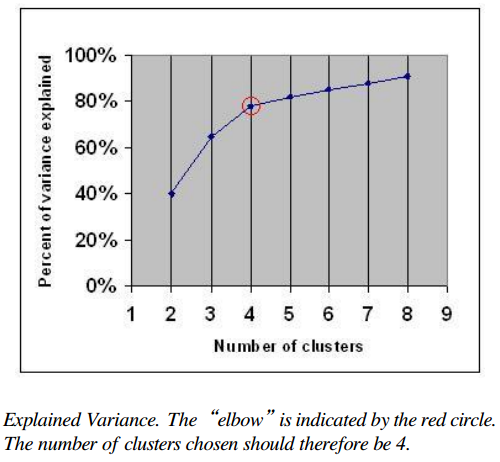資料中聚類個數的確定(Determining the number of clusters in a data set)
本文主要討論聚類中聚類個數的確定問題。
1. K的作用
Intuitively then, the optimal choice of k will strike a balance between maximum compression of the data using a single cluster, and maximum accuracy by assigning each data point to its own cluster.
2. 常用方法
2.1 經驗法則(Rule of thumb)
[1]k≈n/2−−−√
2.2 彎形判據 (The Elbow Method)

the percentage of variance V.S. the number of clusters
2.3 資訊準則(Information Criterion Approach)
[2][3]如果聚類模型能寫成一個似然函式(likelihood function)考慮使用:Akaike information criterion (AIC), Bayesian information criterion (BIC), or the Deviance information criterion (DIC)
[4]是關於k-meas的例子。
2.4 (An Information Theoretic Approach)
[5] 率失真理論 (Rate distortion theory)應用於選擇k,通過資訊理論標準最小化誤差的同時最大化效率。 該策略通過執行一個標準的聚類演算法為輸入資料在k值從1到n生成一個失真曲線(distortion curve),接著基於資料維數選擇的a negative power對失真曲線處理,最後尋找跳躍最大的點作為k。
2.5 輪廓(Choosing k Using the Silhouette)
[6][7]
The silhouette of a datum is a measure of how closely it is matched to data within its cluster and how loosely it is matched to data of the neighbouring cluster.
2.6 交叉驗證法(Cross-validation)
[8]
2.7 文字資料 (Finding Number of Clusters in Text Databases)
[9] 矩陣D∈Rn×m m:文字數量, n:項數量,t:D中非零項數量(D每行列至少有一個非零項),有:( m × n )/ t。
2.8 核矩陣 (Analyzing the Kernel Matrix)
不像先前的方法要求先驗聚類,[10]直接從資料本身獲得聚類個數。
1.形成核矩陣(資料對映到高維空間線性可分)
2.特徵值分解核矩陣
3.分析特徵值和特徵向量
4.畫圖找彎點(elbow)
參考及引用文獻:
[1] [Kanti Mardia et al. (1979). Multivariate Analysis. Academic Press.]
[2] [David J. Ketchen, Jr & Christopher L. Shook (1996). “The application of cluster analysis in Strategic Management Research: An analysis and critique”. Strategic Management Journal 17 (6): 441–458.]
[3] [Cyril Goutte, Peter Toft, Egill Rostrup, Finn Årup Nielsen, Lars Kai Hansen (March 1999). “On Clustering fMRI Time Series” . NeuroImage 9 (3): 298–310.]
[4] [Cyril Goutte, Lars Kai Hansen, Matthew G. Liptrot & Egill Rostrup (2001). “Feature-Space Clustering for fMRI Meta-Analysis” . Human Brain Mapping 13 (3): 165–183.]
[5] [Catherine A. Sugar and Gareth M. James (2003). “Finding the number of clusters in a data set: An information theoretic approach” . Journal of the American Statistical Association 98 (January): 750–763.]
[6] [Peter J. Rousseuw (1987). “Silhouettes: a Graphical Aid to the Interpretation and Validation of Cluster Analysis” . Computational and Applied Mathematics 20: 53–65.]
[7] [R. Lleti, M.C. Ortiz, L.A. Sarabia, M.S. Sánchez (2004). “Selecting Variables for k-Means Cluster Analysis by Using a Genetic Algorithm that Optimises the Silhouettes” . Analytica Chimica Acta 515: 87–100.]
[8] [Finding the Right Number of Clusters in kMeans and EM Clustering: v-Fold Cross-Validation” . Electronic Statistics Textbook. StatSoft. 2010. Retrieved 2010-05-03.]
[9] [Can, F.; Ozkarahan, E. A. (1990). “Concepts and effectiveness of the cover-coefficient-based clustering methodology for text databases” . ACM Transactions on Database Systems 15 (4): 483.]
[10] [Honarkhah, M and Caers, J (2010). “Stochastic Simulation of Patterns Using Distance-Based Pattern Modeling” . Mathematical Geosciences 42 (5): 487–517.]
